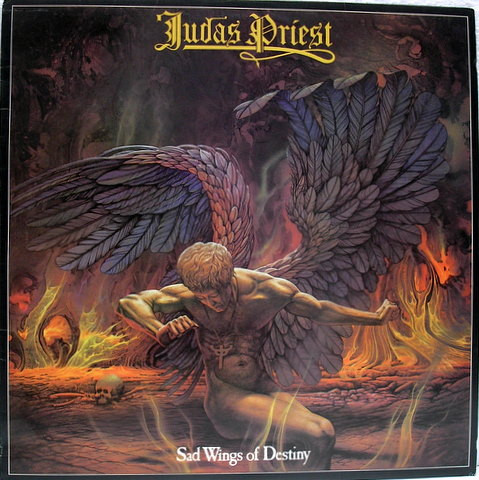„Victim of Changes“, from Judas Priest’s 1976 album Sad Wings of Destiny, is one of the band’s earliest and most iconic epics, blending progressive song structures, bluesy roots, and proto-heavy metal aggression. The song combines two earlier tracks—„Whiskey Woman“ (by Al Atkins, Judas Priest’s original vocalist) and „Red Light Lady“ (by Rob Halford)—into a seamless narrative of lost love, self-destruction, and emotional decay.
At nearly eight minutes long, Victim of Changes unfolds like a tragic opera, beginning with brooding bluesy melancholy, exploding into heavy, electrifying fury, and ending in a slow, doom-laden requiem. Lyrically, it tells the story of a once-passionate love affair that disintegrates due to time, infidelity, and substance abuse.
The song showcases Rob Halford’s extraordinary vocal range, gliding from deep bluesy crooning to glass-shattering screams, while Glenn Tipton and K.K. Downing’s twin-guitar attack shifts between delicate melody and crushing riffs.
Overview
At its core, Victim of Changes explores:
- Lost love and emotional devastation.
- The passage of time and the pain of change.
- Alcoholism and self-destruction.
- Regret, bitterness, and the inability to move on.
It is one of Judas Priest’s most dramatic and emotionally charged songs, acting as a proto-power metal ballad infused with blues and heavy rock intensity.
Narrative Structure
1. The Decline of a Relationship (Lost Love & Change)
- The song opens with a somber, bluesy lament, setting the stage for the tragedy:
„Whiskey woman, don’t you know that you are driving me insane?“ - The woman is self-destructing, possibly due to alcoholism or emotional turmoil.
- The protagonist once loved her deeply, but she is no longer the person she used to be.
- Theme: The corruption of love over time, as one partner descends into self-destruction.
- The guitar work mirrors this tension, starting with a sorrowful, slow riff before building into raw intensity.
2. The Betrayal (Anger & Heartbreak)
- The second section sees the relationship completely disintegrate:
„You’ve gone and left me, and I’m the one that should be crying.“ - She has moved on to another man, leaving the protagonist behind.
- The powerful shift in dynamics (heavy, aggressive guitars and soaring vocals) mirrors the emotional explosion—moving from painful realization to outright fury.
- Betrayal is key here:
- The woman not only changes emotionally but physically, seeking another lover.
- The protagonist feels abandoned, heartbroken, and powerless.
- Halford’s vocals escalate in intensity, shifting from melancholy to an enraged, piercing wail, perfectly capturing the rawness of betrayal.
3. The Realization of Fate (Regret & Bitterness)
- The tone slows down again, creating an almost dreamlike, sorrowful descent:
„Take another look around, you’re not going anywhere.“ - The woman is trapped in her choices, perhaps realizing her mistake.
- The protagonist, though deeply hurt, also recognizes that life moves on.
- A grim acceptance sets in—nothing stays the same, and everyone is a victim of change.
4. The Doom-Laden Climax (Tragic Finality)
- The final verse carries a sense of inevitability and deep regret:
„Changes, changes, victim of changes.“ - The protagonist acknowledges that both of them have suffered due to time and their choices.
- Nothing can be undone, and the past is gone forever.
- Musically, the song slows into a crushing, doom-like passage—the guitar chords ring out like funeral bells, reinforcing the sense of finality and loss.
- The last, drawn-out scream from Halford is pure devastation, echoing the agony of watching everything slip away.
Themes & Symbolism
1. Time as a Destructive Force
- The song highlights how time inevitably changes people and relationships.
- Love, once pure and passionate, is now tainted by regret, alcohol, and loss.
2. Alcoholism & Self-Destruction
- The woman’s „whiskey-driven“ downfall represents how addiction or emotional wounds can erode even the strongest bonds.
- The song does not vilify her, but rather paints her as a tragic figure consumed by her demons.
3. The Inescapability of Change
- No one can stop change, whether it’s physical, emotional, or circumstantial.
- Both the protagonist and the woman are victims—caught in the cycle of time, loss, and transformation.
4. Betrayal & Emotional Wounds
- The pain of watching someone you love turn into a stranger is central to the song’s emotional impact.
- Even after she leaves, the protagonist is still haunted by her—his pain doesn’t fade, it lingers like an open wound.
Musical & Emotional Impact
1. The Slow-Building, Blues-Infused Opening
- Glenn Tipton’s and K.K. Downing’s twin guitars create a sorrowful, slow-burning intro that gradually builds tension.
- The opening melody is soaked in blues and sadness, making the listener feel the protagonist’s pain immediately.
2. The Explosive, Metal Fury of the Midsection
- As anger and betrayal set in, the song explodes into heavy, aggressive guitar work, mirroring the emotional chaos of heartbreak.
- Halford’s vocals ascend into the stratosphere, capturing rage, disbelief, and agony all at once.
3. The Haunting, Doom-Like Conclusion
- The song slows into a crushing, mournful outro, emphasizing the finality of loss.
- Halford’s final screams are legendary, like a man wailing into the void, powerless against time and fate.
Legacy & Influence
- One of Judas Priest’s defining early epics, helping shape the sound of heavy metal.
- A perfect blend of bluesy emotion and metallic aggression, later influencing bands like Iron Maiden, Queensrÿche, and even progressive metal acts.
- Rob Halford’s vocal performance is legendary, showcasing the emotional range that would become a staple of heavy metal singers.
- A concert staple, often featuring extended solos and crowd-stirring intensity.
Final Verdict
„Victim of Changes“ is a masterclass in heavy metal storytelling—combining melancholy, fury, and despair into a seamless, emotional odyssey. With haunting melodies, explosive guitar work, and one of Halford’s most iconic vocal performances, the song captures the pain of love lost, the cruelty of time, and the inescapable nature of change.
A heavy metal opera of love, loss, and inevitable fate.



